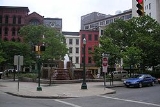
Hanover Square, Syracuse
Encyclopedia
Hanover Square in Downtown Syracuse
, New York
, is a triangular-shaped public park located at the intersection of Warren, Water, and East Genesee streets. The triangle was originally named Veteran's Park.
The name may also refer to the larger Hanover Square Historic District which includes seventeen historic buildings in the area that was the first commercial district in Syracuse. In the warm weather months, entertainment is common on the plaza around the fountain. Workers in the surrounding office buildings and retail establishments often lunch there.
in 1910 and the function of commemorating Syracuse's
war dead was shifted there.
The trianguler shape of the park came as a result of the city's new grid street system in the early 19th century which was "superimposed on the diagonal route" of early Genesee Turnpike (now known as Genesee Street).
The larger, Clinton Square
, the city's town center located to the west, had developed first, however, following the completion of the Erie Canal
in 1825, commercial and retail activity spread along Genesee Street to Hanover Square.
was still a village, the village well was located in Hanover Square.
In the 1820s, a group of shops called the Hanover Arcade were located where the State Tower Building
now stands.
The buildings on Water Street were backed by the Erie Canal
, and were known as “double-enders.” This facilitated the unloading of goods from barges on the canal. Civil War
recruiting booths were set up in the square, and were made into a huge bonfire at the end of the war.
In March 1834, the area was devastated by fire which destroyed all the buildings on the north side of the square, next to the canal. That same year, the buildings were replaced with narrow, brick structures in the Federal
style of architecture and known as the Phoenix Buildings four of which still stand today on the northern edge of the square.
Later in 1834, the owners of the wooden buildings on the south side of the square erected a similar row of brick buildings along East Genesee Street known as the Franklin buildings. The area was soon known as Franklin Square
. Three of the buildings are still standing today.
Similar to Clinton Square
, the public space became an "important center" of social and political life in the city with its "public meetings, demonstrations and partisan speeches." After 1840, the railroad brought additional commerce to the intersection.
In 1865, after Abraham Lincoln
's funeral procession traveled through Syracuse on the way to Springfield, Illinois
, thousands came to the square to hear eulogies for the former president.
commercial development. At one time, banks and theaters lined the square which was originally known as Veteran's Park. Throughout the years, the square served as a transportation hub for railroads and trolleys and was a busy commercial center.
At one time, the square served as a "hack stand" where drivers would hire out their wagons to local merchants. For years, many pedestrians, especially women, complained that they could not safely travel from one side of the square to the other due to the standing carts, mud and moving vehicles.
since 1976, the square is an intact, mainly nineteenth century historic district.
The square is a National Register Historic District and a Local Preservation District whose buildings represent over 100 years of architecture and was the firsr in the city on the register.
Hanover Square has changed little since the Civil War
. Several of the buildings date to the period that ran from 1830 through 1860. Newer buildings date to the late 19th century, such as the Onondaga County Savings Bank
which was constructed in 1896.
The buildings in the square encompass a myriad of architectural styles building over a period of several years including; Federal
, Greek Revival
, Second Empire, Italianate
, Romanesque
, Sullivanesque, Victorian Gothic, Queen Anne
, Neo-classical and Art Deco
are all represented.
The center of the square showcases a fountain and plaza where lunchtime entertainment is available during the summer months. The plaza is faced on both sides by various storefronts including cafes, pubs and salons.
In addition to modern businesses, eateries and stores, loft-style apartments have been created on the upper floors of some of Hanover Square's historic buildings.
Businesses in Hanover Square include:
The 23-floor State Tower Building overlooking the square hosts offices and is a major telecommunications hub for downtown Syracuse.
Downtown Syracuse
Downtown Syracuse is the economic center of Syracuse, New York, and Central New York, employing over 30,000 people, and housing over 2,000. It is also one of the 26 officially recognized neighborhoods of Syracuse.- History :...
, New York
New York
New York is a state in the Northeastern region of the United States. It is the nation's third most populous state. New York is bordered by New Jersey and Pennsylvania to the south, and by Connecticut, Massachusetts and Vermont to the east...
, is a triangular-shaped public park located at the intersection of Warren, Water, and East Genesee streets. The triangle was originally named Veteran's Park.
The name may also refer to the larger Hanover Square Historic District which includes seventeen historic buildings in the area that was the first commercial district in Syracuse. In the warm weather months, entertainment is common on the plaza around the fountain. Workers in the surrounding office buildings and retail establishments often lunch there.
History
The public square was originally named Veteran's Park. It was renamed to Hanover Square after the Soldiers' and Sailors' Monument was dedicated in Clinton SquareClinton Square
Clinton Square, in downtown Syracuse, New York, was the original town center and first came into existence in the early 19th century where roadways from north and south convened...
in 1910 and the function of commemorating Syracuse's
Syracuse, New York
Syracuse is a city in and the county seat of Onondaga County, New York, United States, the largest U.S. city with the name "Syracuse", and the fifth most populous city in the state. At the 2010 census, the city population was 145,170, and its metropolitan area had a population of 742,603...
war dead was shifted there.
The trianguler shape of the park came as a result of the city's new grid street system in the early 19th century which was "superimposed on the diagonal route" of early Genesee Turnpike (now known as Genesee Street).
The larger, Clinton Square
Clinton Square
Clinton Square, in downtown Syracuse, New York, was the original town center and first came into existence in the early 19th century where roadways from north and south convened...
, the city's town center located to the west, had developed first, however, following the completion of the Erie Canal
Erie Canal
The Erie Canal is a waterway in New York that runs about from Albany, New York, on the Hudson River to Buffalo, New York, at Lake Erie, completing a navigable water route from the Atlantic Ocean to the Great Lakes. The canal contains 36 locks and encompasses a total elevation differential of...
in 1825, commercial and retail activity spread along Genesee Street to Hanover Square.
Public square
When SyracuseSyracuse, New York
Syracuse is a city in and the county seat of Onondaga County, New York, United States, the largest U.S. city with the name "Syracuse", and the fifth most populous city in the state. At the 2010 census, the city population was 145,170, and its metropolitan area had a population of 742,603...
was still a village, the village well was located in Hanover Square.
In the 1820s, a group of shops called the Hanover Arcade were located where the State Tower Building
State Tower Building
The State Tower Building is a high-rise building located in Syracuse, New York. Completed in 1928, the building remains the highest in Syracuse to date. It has 23 floors and rises 95.4 meters into the air...
now stands.
The buildings on Water Street were backed by the Erie Canal
Erie Canal
The Erie Canal is a waterway in New York that runs about from Albany, New York, on the Hudson River to Buffalo, New York, at Lake Erie, completing a navigable water route from the Atlantic Ocean to the Great Lakes. The canal contains 36 locks and encompasses a total elevation differential of...
, and were known as “double-enders.” This facilitated the unloading of goods from barges on the canal. Civil War
American Civil War
The American Civil War was a civil war fought in the United States of America. In response to the election of Abraham Lincoln as President of the United States, 11 southern slave states declared their secession from the United States and formed the Confederate States of America ; the other 25...
recruiting booths were set up in the square, and were made into a huge bonfire at the end of the war.
Commercial center
The first buildings in the square were a church and several wooden structures which were both residential and commercial.In March 1834, the area was devastated by fire which destroyed all the buildings on the north side of the square, next to the canal. That same year, the buildings were replaced with narrow, brick structures in the Federal
Federal architecture
Federal-style architecture is the name for the classicizing architecture built in the United States between c. 1780 and 1830, and particularly from 1785 to 1815. This style shares its name with its era, the Federal Period. The name Federal style is also used in association with furniture design...
style of architecture and known as the Phoenix Buildings four of which still stand today on the northern edge of the square.
Later in 1834, the owners of the wooden buildings on the south side of the square erected a similar row of brick buildings along East Genesee Street known as the Franklin buildings. The area was soon known as Franklin Square
Franklin Square, Syracuse
Franklin Square is a former industrial neighborhood, turned residential and commercial, in Syracuse New York. Officially it is part of the larger Lakefront neighborhood, which in turn is one of Syracuse's 26 officially recognized neighborhoods.-History:...
. Three of the buildings are still standing today.
Similar to Clinton Square
Clinton Square
Clinton Square, in downtown Syracuse, New York, was the original town center and first came into existence in the early 19th century where roadways from north and south convened...
, the public space became an "important center" of social and political life in the city with its "public meetings, demonstrations and partisan speeches." After 1840, the railroad brought additional commerce to the intersection.
In 1865, after Abraham Lincoln
Abraham Lincoln
Abraham Lincoln was the 16th President of the United States, serving from March 1861 until his assassination in April 1865. He successfully led his country through a great constitutional, military and moral crisis – the American Civil War – preserving the Union, while ending slavery, and...
's funeral procession traveled through Syracuse on the way to Springfield, Illinois
Springfield, Illinois
Springfield is the third and current capital of the US state of Illinois and the county seat of Sangamon County with a population of 117,400 , making it the sixth most populated city in the state and the second most populated Illinois city outside of the Chicago Metropolitan Area...
, thousands came to the square to hear eulogies for the former president.
Transportation hub
Hanover Square has played a vital role in Syracuse'sSyracuse, New York
Syracuse is a city in and the county seat of Onondaga County, New York, United States, the largest U.S. city with the name "Syracuse", and the fifth most populous city in the state. At the 2010 census, the city population was 145,170, and its metropolitan area had a population of 742,603...
commercial development. At one time, banks and theaters lined the square which was originally known as Veteran's Park. Throughout the years, the square served as a transportation hub for railroads and trolleys and was a busy commercial center.
At one time, the square served as a "hack stand" where drivers would hire out their wagons to local merchants. For years, many pedestrians, especially women, complained that they could not safely travel from one side of the square to the other due to the standing carts, mud and moving vehicles.
Historic district
Listed on the National Register of Historic PlacesNational Register of Historic Places
The National Register of Historic Places is the United States government's official list of districts, sites, buildings, structures, and objects deemed worthy of preservation...
since 1976, the square is an intact, mainly nineteenth century historic district.
The square is a National Register Historic District and a Local Preservation District whose buildings represent over 100 years of architecture and was the firsr in the city on the register.
Hanover Square has changed little since the Civil War
Civil war
A civil war is a war between organized groups within the same nation state or republic, or, less commonly, between two countries created from a formerly-united nation state....
. Several of the buildings date to the period that ran from 1830 through 1860. Newer buildings date to the late 19th century, such as the Onondaga County Savings Bank
Onondaga County Savings Bank
The Onondaga County Savings Bank was chartered in 1855 in Syracuse, New York. It was a franchise ahead of its time and had four separate branches by the late 19th century...
which was constructed in 1896.
Hanover Square Historic District contributing Properties
The 17 properties can by visited in order, starting at South Salina Street and Water Street, going east on Water Street, turning south on Warren Street, and returning on the diagonal along East Genesee Street to Water Street.The buildings in the square encompass a myriad of architectural styles building over a period of several years including; Federal
Federal architecture
Federal-style architecture is the name for the classicizing architecture built in the United States between c. 1780 and 1830, and particularly from 1785 to 1815. This style shares its name with its era, the Federal Period. The name Federal style is also used in association with furniture design...
, Greek Revival
Greek Revival architecture
The Greek Revival was an architectural movement of the late 18th and early 19th centuries, predominantly in Northern Europe and the United States. A product of Hellenism, it may be looked upon as the last phase in the development of Neoclassical architecture...
, Second Empire, Italianate
Italianate architecture
The Italianate style of architecture was a distinct 19th-century phase in the history of Classical architecture. In the Italianate style, the models and architectural vocabulary of 16th-century Italian Renaissance architecture, which had served as inspiration for both Palladianism and...
, Romanesque
Romanesque architecture
Romanesque architecture is an architectural style of Medieval Europe characterised by semi-circular arches. There is no consensus for the beginning date of the Romanesque architecture, with proposals ranging from the 6th to the 10th century. It developed in the 12th century into the Gothic style,...
, Sullivanesque, Victorian Gothic, Queen Anne
Queen Anne Style architecture
The Queen Anne Style in Britain means either the English Baroque architectural style roughly of the reign of Queen Anne , or a revived form that was popular in the last quarter of the 19th century and the early decades of the 20th century...
, Neo-classical and Art Deco
Art Deco
Art deco , or deco, is an eclectic artistic and design style that began in Paris in the 1920s and flourished internationally throughout the 1930s, into the World War II era. The style influenced all areas of design, including architecture and interior design, industrial design, fashion and...
are all represented.
| Landmark name | Image | Date Built | Style | Location | Description | |
|---|---|---|---|---|---|---|
| 1 | Gridley Building Gridley Building The Gridley Building, built in 1867 and known previously as the Onondaga County Savings Bank Building, is a prominent historic building on Clinton Square and Hanover Square in Syracuse, New York... |
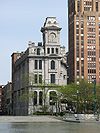 |
1867 | Second Empire | 101 East Water Street |
Also known as the Onondaga County Savings Bank Building; 3½ stories; 100 foot clock tower; built of Onondaga limestone; Horatio Nelson White Horatio Nelson White Horatio Nelson White was an American architect.He was one of New York State's most prominent architects from about 1865 to 1880. A resident of Syracuse, he designed many homes, armories, churches, and public buildings throughout sentralNew York State, included: The Hall of Languages at Syracuse... , architect |
| 2 | Gere Bank Building Gere Bank Building The Gere Bank Building is a five story building located on Water Street in Syracuse, New York. It was designed by Charles Colton, and built in 1894. It is distinctive for its facade and use of contrasting materials. The cost of the building was $150,000, including nearly $50,000 for fireproof... |
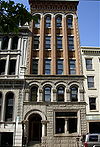 |
1894 | Louis Sullivan type | 121 East Water Street |
5 stories; built of granite, brick and terra cotta; Charles Colton, architect |
| 3 | Phoenix Buildings (portion) |  |
1834 | Federal | 123 East Water Street |
4 stories; brick |
| 4 | Phillips Block |  |
1834 | Federal | 125-127 East Water Street |
4 stories; brick |
| 5 | Phoenix Buildings (portion) | 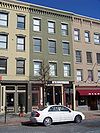 |
1834 | Federal | 129 East Water Street |
4 stories; brick |
| 6 | Dana Building |  |
1837, 1861 | Federal, Italianate | 135 East Water Street |
Italianate top floor added in 1861; 4 stories; brick |
| 7 | Grange Building |  |
1925 | Commercial | 203 East Water Street |
Originally an auto dealership; 4 stories; brown brick |
| 8 | State Tower Building State Tower Building The State Tower Building is a high-rise building located in Syracuse, New York. Completed in 1928, the building remains the highest in Syracuse to date. It has 23 floors and rises 95.4 meters into the air... |
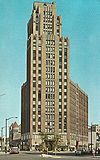 |
1927 | Art Deco | 109 South Warren Street |
22 stories; brick and limestone; Thompson and Churchill, architects |
| 9 | Granger Block | 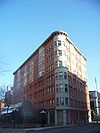 |
1869, 1894 | Renaissance Revival | 200 East Genesee Street |
Also known as the SA&K (Sedgwick, Andrews and Kennedy) Building and Ferary Building; first 4 stories built in 1869; upper three stories added in 1894; brick |
| 10 | Larned Building |  |
1869 | Second Empire | 114 South Warren Street |
5 stories; brick |
| 11 | Post Standard Building | 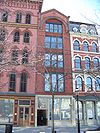 |
1880 | Richardsonian Romanesque | 136 East Genesee Street |
5 stories; brick |
| 12 | Franklin Buildings (portion) |  |
1870 | Second Empire | 134 East Genesee Street |
4½ stories; brick |
| 13 | Franklin Buildings (portion) |  |
Federal | 132 East Genesee Street |
4 stories; stone | |
| 14 | Franklin Buildings (portion) | 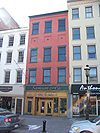 |
1834 | Federal | 128 East Genesee Street |
4 stories; brick |
| 15 | Franklin Buildings (portion) | 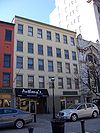 |
1839 | Federal | 122-126 East Genesee Street |
5 stories; brick |
| 16 | Flagship Securities Building | 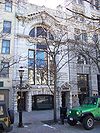 |
1896 | Neo-Classical | 120 East Genesee Street |
3 stories; marble and brick; Albert L. Brockway, architect; first steel-framed building in downtown Syracuse |
| 17 | Onondaga County Savings Bank Onondaga County Savings Bank The Onondaga County Savings Bank was chartered in 1855 in Syracuse, New York. It was a franchise ahead of its time and had four separate branches by the late 19th century... |
 |
1896 | Neo-Classical | 113 South Salina Street |
9½ stories; granite and limestone; R.W. Gibson, architect; Angelo Magnanti designed plaster ceiling; William Teff Schwartz murals of Onondaga County history |
Today
The park is now a major setting for ceremonial and cultural gatherings where shade trees and annual plantings "complement the water sculpture."The center of the square showcases a fountain and plaza where lunchtime entertainment is available during the summer months. The plaza is faced on both sides by various storefronts including cafes, pubs and salons.
In addition to modern businesses, eateries and stores, loft-style apartments have been created on the upper floors of some of Hanover Square's historic buildings.
Businesses in Hanover Square include:
- Bull and Bear Pub
- Coffee Pavilion
- Downtown Manhattan's
- Koolakian and Manro Menswear
- munly brown studio
- Anthony's Pasta Bar
- Niko's
- Wild Will's Saloon
- Nick's Place (in the M&T Building)
The 23-floor State Tower Building overlooking the square hosts offices and is a major telecommunications hub for downtown Syracuse.

